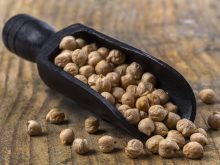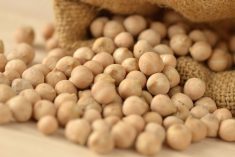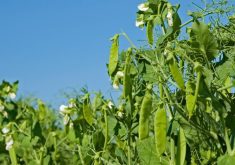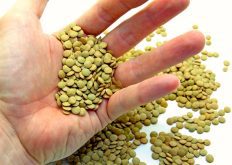CNS Canada — Low yields and poor quality have caused Canadian chickpea price quotes to shoot higher.
Very little of the crop actually falls under the top grades, however, leaving the bulk of the marketing to take place in the feed sector.
“The chickpea harvest has been an unmitigated disaster,” said Colin Young of Midwest Investments at Moose Jaw, Sask.
Dryness at seeding time was followed by unprecedented rainfall over the summer, which led to considerable disease issues and stripped away both yields and quality.
Read Also

U.S. grains: Corn, soybeans higher in technical bounce; wheat firms
Chicago | Reuters – Chicago corn futures rose modestly on Thursday on chart-based buying, firm cash markets and reminders of…
Then, to add insult to injury, poor harvest weather likely led to about 10 to 20 per cent of the seeded acres being abandoned.
Chickpeas grading No. 2 or better are commanding a premium, with prices as high as 65 to 70 cents/lb. quoted from some buyers, according to Young.
However, while southern Alberta and the US had relatively good-quality chickpeas, those crops are already spoken for and Young said “virtually none” of the remaining chickpeas fit the bill.
In the 17 years he’s been marketing chickpeas, Young said 2016-17 “is by far the most devastating quality,” with high amounts of mould a particular challenge.
Before the harvest, Statistics Canada estimated the chickpea crop at 114,000 tonnes, which would compare with 90,000 tonnes the previous year. However, with the abandoned acres and poor yields, Young estimated the crop may be only 60,000 tonnes, with half to two-thirds of that straight feed.
Speaking about his own farm, Young noted the quality ranges from “really awful-looking feed, to quite nice-looking feed.”
One silver lining is that the feed market is paying a significant premium over traditional feed prices, with feed prices in the 25-32 cents/lb. range.
“We’re selling feed chickpeas for a higher price than we were selling No. 1 chickpeas two years ago,” said Young.
Looking ahead to next year, while high prices usually encourage additional acres, the disappointing 2016 crop may dissuade some planted area.
Young also expected seed shortages would provide a natural barrier to chickpea acres.
“Canada being out of chickpeas is like the corner store being out of milk,” Young added, noting that despite the localized issues, the world market will still be set by prices in the larger-producing countries such as Russia, the U.S., Argentina, India and Australia.
While that may be the case, Young said international customers still like Canadian chickpeas and will be ready to buy again when the quality improves.
— Phil Franz-Warkentin writes for Commodity News Service Canada, a Winnipeg company specializing in grain and commodity market reporting. Follow him at @PhilFW on Twitter.
















